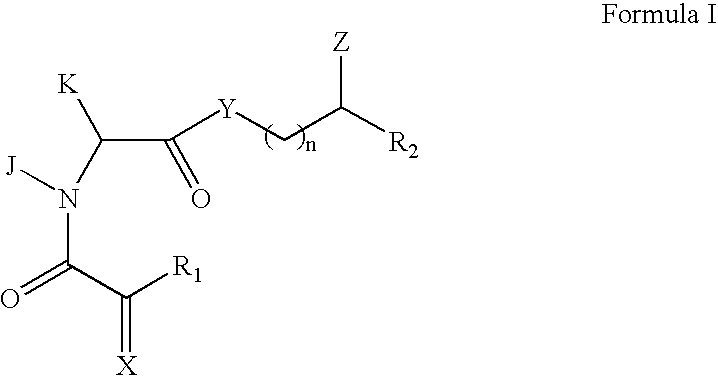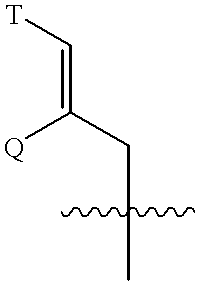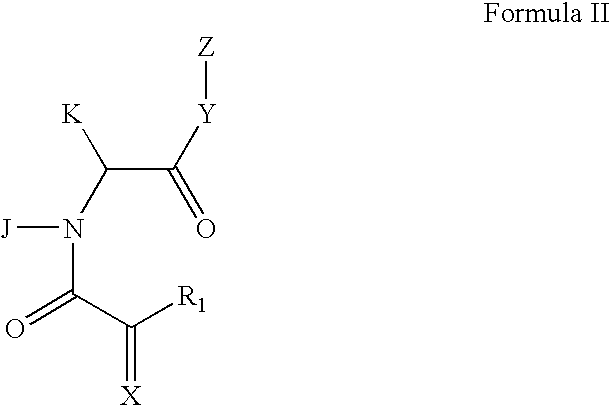Rotamase enzyme activity inhibitors
a rotamase enzyme and inhibitor technology, applied in the field of neurotrophic compounds, can solve the problems of insufficient immunosuppressant activity, hampered clinical application of these proteins in various neurological disease states, and immunosuppressants exhibit a number of potentially serious side effects, so as to promote neuronal regeneration, and stimulate the growth of damaged peripheral nerves
- Summary
- Abstract
- Description
- Claims
- Application Information
AI Technical Summary
Benefits of technology
Problems solved by technology
Method used
Image
Examples
example 1
[0077]Synthesis of methyl (2S)-1-(1,2-dioxo-2-methoxyethyl)-2-pyrrolidinecarboxylate.
[0078]A solution of L-proline methyl ester hydrochloride (3.08 g; 18.60 mmol) in dry methylene chloride was cooled to 0° C. and treated with triethylamine (3.92 g; 38.74 mmol; 2.1 eq). After stirring the formed slurry under a nitrogen atmosphere for 15 min, a solution of methyl oxalyl chloride (3.20 g; 26.12 mmol) in methylene chloride (45 mL) was added dropwise. The resulting mixture was stirred at 0° C. for 1.5 hr. After filtering to remove solids, the organic phase was washed with water, dried over MgSO4 and concentrated. The crude residue was purified on a silica gel column, eluting with 50% ethyl acetate in hexane, to obtain 3.52 g (88%) of the product as a reddish oil. Mixture of cis-trans amide rotamers; data for trans rotamer given. 1H NMR (CDCl3): d 1.93 (dm, 2H); 2.17 (m, 2H); 3.62 (m, 2H); 3.71 (s, 3H); 3.79, 3.84 (s, 3H total); 4.86 (dd, 1H, J=8.4, 3.3).
example 2
[0079]General procedure for the synthesis of pyrrolidinyl alkyl oxamates. Exemplified for methyl (2S)-1-(1,2-dioxo-3,3-dimethylpentyl)-2-pyrrolidinecarboxylate.
[0080]A solution of methyl (2S)-1-(1,2-dioxo-2-methoxyethyl)-2-pyrrolidinecarboxylate (2.35 g; 10.90 mmol) in 30 mL of tetrahydrofuran (THF) was cooled to −78° C. and treated with 14.2 mL of a 1.oM solution of 1,1-dimethylpropylmagnesium chloridein THF. After stirring the resulting homogenous mixture at −78° C. for three hours, the mixture was poured into saturated ammonium chloride (100 mL) and extracted into ethyl acetate. The organic phase was washed with water, dried, and concentrated, and the crude material obtained upon removal of the solvent was purified on a silica gel column, eluting with 25% ethyl acetate in hexane, to obtain 2.10 g (75%) of the oxamate as a colorless oil. 1H NMR (CDCl3): d 0.88 (t, 3H); 1.22,1.26 (s, 3H each); 1.75 (dm, 2H); 1.87–2.10 (m, 3H); 2.23 (m, 1H); 3.54 (m, 2H); 3.76 (s, 3H); 4.52 (dm, 1H,...
example 3
[0081]General procedure for the preparation of pyrrolidine carboxylic acids. Exemplified for (2S)-1-(1,2-dioxo-3,3-dimethylpentyl)-2-pyrrolidinecarboxylic acid.
[0082]A mixture of methyl (2S)-1-(1,2-dioxo-3,3-dimethylpentyl)-2-pyrrolidinecarboxylate (2.10 g; 8.23 mmol), 1 N LiOH (15 mL), and methanol (50 mL) was stirred at 0° C. for 30 min and at room temperature overnight. The mixture was acidified to pH 1 with 1 N HCl, diluted with water, and extracted into 100 mL of methylene chloride. The organic extract was washed with brine and concentrated to deliver 1.73 g (87%) of snow-white solid which did not require further purification. 1H NMR (CDCl3): δ 0.87 (t, 3H); 1.22, 1.25 (s, 3H each); 1.77 (dm, 2H); 2.02 (m, 2H); 2.17 (m, 1H); 2.25 (m, 1H); 3.53 (dd, 2H, J=10.4, 7.3); 4.55 (dd, 1H, J=8.6, 4.1).
PUM
| Property | Measurement | Unit |
|---|---|---|
| concentrations | aaaaa | aaaaa |
| absorbance versus time | aaaaa | aaaaa |
| temperature | aaaaa | aaaaa |
Abstract
Description
Claims
Application Information
 Login to View More
Login to View More - R&D
- Intellectual Property
- Life Sciences
- Materials
- Tech Scout
- Unparalleled Data Quality
- Higher Quality Content
- 60% Fewer Hallucinations
Browse by: Latest US Patents, China's latest patents, Technical Efficacy Thesaurus, Application Domain, Technology Topic, Popular Technical Reports.
© 2025 PatSnap. All rights reserved.Legal|Privacy policy|Modern Slavery Act Transparency Statement|Sitemap|About US| Contact US: help@patsnap.com



